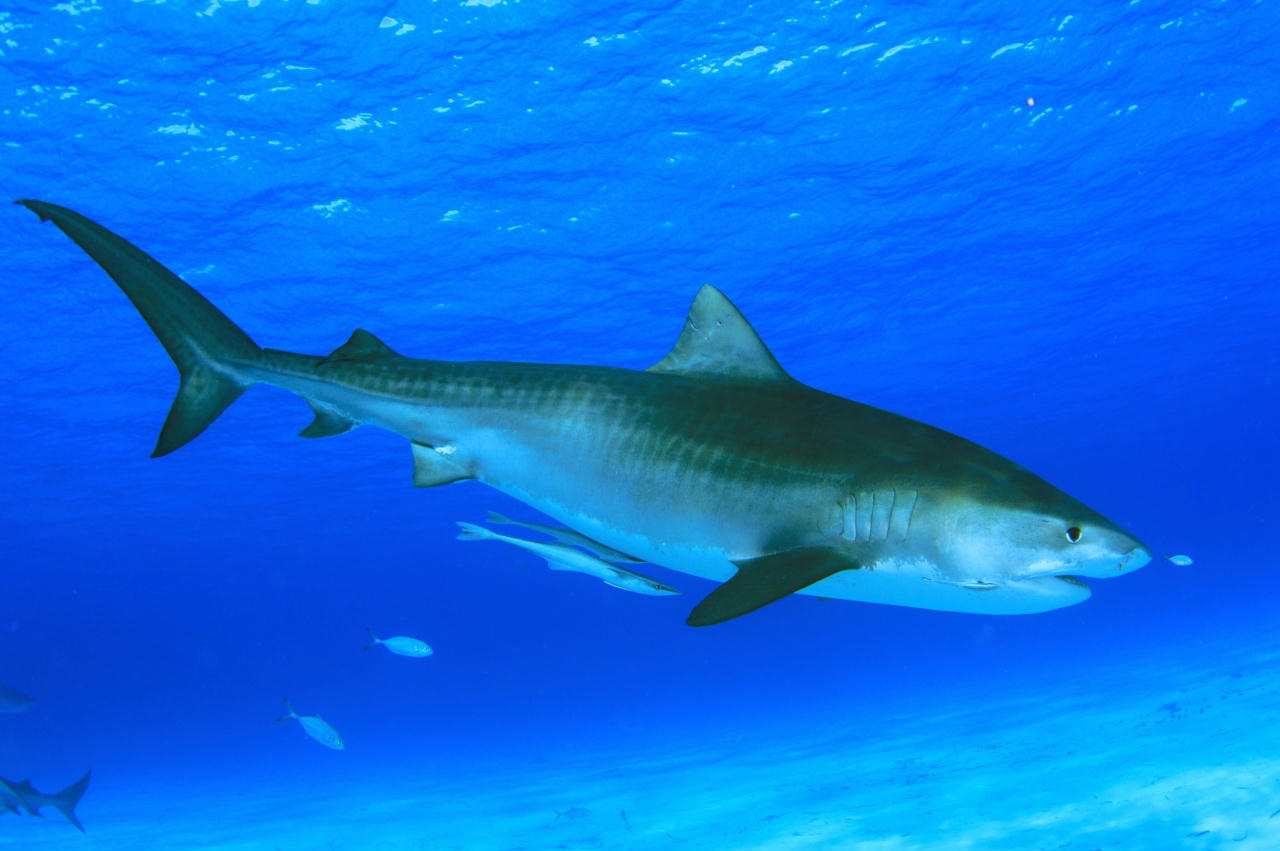Tiger Shark, Galeocerdo cuvier (Péron & Lesueur 1822)

A Tiger Shark, Galeocerdo cuvier, in the Bahamas. Source: Kevin Bryant / Flickr. License: CC by Attribution-NonCommercial-ShareAlike
A large greyish shark with narrow darker bars and reticulations along the body that fade in larger specimens, and a pale underside. The head is broad with a short, blunt snout, and the cockscomb-shaped teeth in both jaws, each with single cusp and large serrations, on both edges.
This aggressive shark feeds indiscriminately on a variety of prey, carrion and human rubbish. Tiger sharks frequently enter shallow waters, especially at night, and are considered extremely dangerous to humans.
Dive Magazine video of Tiger Sharks
Video of a juvenile Tiger Shark being fed in the Cairns Marine facility.
Tiger Shark, Galeocerdo cuvier (Péron & Lesueur 1822)
More Info
|
Distribution |
Found worldwide in all tropical and warm temperate seas - straying into warm-temperate areas during warmer months. Tiger sharks are usually associated with warmer waters, although they venture into southern waters between December and April. The species is rare in Bass Strait and the Great Australian Bight, and very uncommon in Tasmania, having only been recorded in the north of the State. Tiger sharks inhabit inshore and offshore waters to the outer continental shelf and upper slope, often around coral reefs, and sometimes well offshore into pelagic waters. While the species mostly occurs above 100 metres, tagging studies have shown that Tiger Sharks may dive to depths below 1000 m. Individuals may also travel thousands of kilometres across ocean basins. |
|
Features |
Vertebrae (precaudal) 102-109; (total) 222-226. Body streamlined; caudal peduncle with lateral keels; upper and lower precaudal pits present. Head slightly flattened above; snout very short, bluntly rounded (length to mouth 3-5% TL); nostril not connected to mouth by groove; eyes oval; spiracles present as small, narrow slits; upper labial furrows long, equal to length of snout in front of mouth; mouth large (80-83% head width); teeth cockscomb-shaped in both jaws, each with single cusp and large serrations, on both edges; five gill slits, last above pectoral fin. Interdorsal ridge present. Two dorsal fins, second much smaller than first, origin of first dorsal over, or slightly posterior to axil of pectoral fin; anal fin of similar size to second dorsal, origin just posterior to that of second dorsal; caudal fin heterocercal, upper lobe long with a thin, tapering tip, sub-terminal notch present, lower lobe well developed. Pectoral fin of moderate size, nearly pointed, with a concave hind margin. |
|
Size |
Maximum known total length 740 cm, although most individuals are less than 500 cm TL. |
|
Colour |
Upper surfaces grey with dark bars and reticulations in juveniles, becoming faint in adults over 3 m; underside pale. |
|
Feeding |
Apex predators in tropical seas, and an indiscrimate omnivore and scavenger. Randall (1992) concluded that tiger sharks may have the most diverse diet of any shark species. Prey includes bony fishes, sharks, rays, turtles, sea birds, seals, dolphins, sea snakes, cephalopods, crabs, lobsters, gastropods and jellyfish. They also consume carrion, including whale carcasses, and readily take baited hooks. Tiger sharks also consume rubbish of human origin, including plastics, metal, sacks, kitchen scraps and almost any other item discarded in the sea. Juveniles generally feed on fishes, crustaceans and other invertebrates. As they grow, the diet expands to include more diverse prey with age such as turtles, sharks and rays, and marine mammals. |
|
Biology |
The Tiger Shark is the only species in the family Carcharhinidae that is lecitrophic viviparous - meaning that the developing embryos live completely off the yolk, but the fully developed pup is born alive. Males mature at a about 3 m in length and females at 3.3 m. Females give birth during summer to large litters of 10-80 pups, born at 50–90 cm TL, following a 15-16 month gestation period. |
|
Fisheries |
Targetted or taken as bycatch in commercial, recreational and artisanal fisheries worldwide. Although not used commercially in Australia, Tiger Sharks are regularly hooked by sports fishers off eastern Australia. Tiger Sharks are a major component of catches from shark control programs in Australia. |
|
Conservation |
IUCN Near Threatened |
|
Etymology |
The species was named in honour of Georges Cuvier. |
|
Species Citation |
Squalus cuvier Péron & Lesueur, in Lesueur 1822, Journal of the Academy of Natural Sciences of Philadelphia 2(2): 351. Type locality: north-west Australia (as north-west coast of New Holland). |
|
Author |
Bray, D.J. 2022 |
|
Resources |











